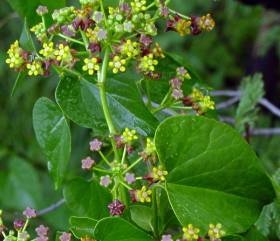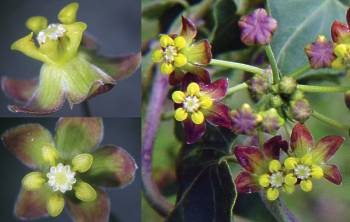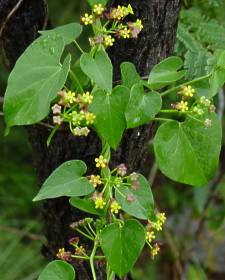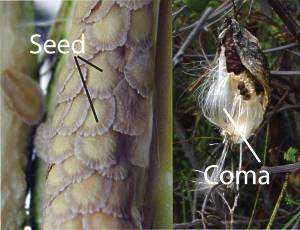Pentarrhinum insipidum
Pentarrhinum insipidum E.Mey.
Family: Apocynaceae
Common names: African heartvine (Eng.), donkieperske, hondepisbossie, opklim, wildekomkommer (Afr.), aulana, furana (Ndebele), umulugwe (Ndebele), leswa (Sotho)
Introduction
The leaves, stems and fruit of Pentarrhinum insipidum are widely eaten throughout Africa. It is an important wild vegetable and has the potential to be cultivated as a commercial vegetable. It is rich in calcium, magnesium, iron, riboflavin and copper. It is an aggressive grower and in slightly disturbed areas exhibits invasive tendencies.

Description
Description
Pentarrhinum insipidum is a slender, fast-growing, branching vine that sprouts from a woody, perennial rootstock and produces stems 2-3 m long. It scrambles over other shrubs or twines itself around trees and bushes. All the parts are delicately covered with hairs. The leaves are simple, stalked and broadly ovate to heart-shaped with a deep cordate base and pointed tip; the leaf blade is 200-650 x 15-50 mm; the stalks are 15-50 mm long, usually pointing downwards.

The corollas of the flowers are reflexed, arranged in lateral pseudo-umbels which hang from the nodes and are small, greenish to yellow, with the basal parts of the corolla sometimes tinged purple to brown. A white form occurs in the coastal areas of KwaZulu-Natal. The corona is white, beige, yellow or orange to brown-greenish, fleshy with a horn-like appendage. Flowers are fragrant and aromatic and are produced from November to April. The fruit is usually a solitary follicle, somewhat inflated, lance-shaped with an uneven, warty surface, 55-85 x 15-20 mm, with teeth 2-4 mm long. The seed is 6.0-6.5 x 4 mm, tightly packed, flat, with a marginal wing and with a tuft of white hairs at the one end.

Conservation Status
Status
This plant is currently neither threatened nor protected, but widespread and quite common where it occurs.

Distribution and habitat
Distribution description
The African heartvine is endemic to Africa. It is distributed in two large disjunct regions: 1, South Africa, Namibia, Botswana, Zimbabwe, Mozambique and Malawi ; and 2, northern Zambia, Tanzania, Kenya and Ethiopia, with smaller outliers probably reflecting the different ecological and climatic conditions in Africa.
It is widespread in grassland, bush-clumps, savanna or forest margins. It can be cultivated almost anywhere-from areas with strong frost to hot and humid areas. It dies back in unfavourable conditions and resprouts in springtime.
Derivation of name and historical aspects
History
The generic name is derived from the Greek words penta meaning 'five' and rhynchos meaning 'snout', which probably refers to the shape of the corona. The epithet insipidus is Latin and means 'to be without taste'. The genus is restricted to Africa and consists of three species of which two are found in southern Africa.
This species was first described in 1738 by Burmann (at that time placed in the genus Cynanchum ). The plant was moved to its own genus, Pentarrhinum, in 1837 by Ernest Meyer. Subsequently five more species were described but most of them were later sunk into synonymy. The placement of the genus in relation to other genera remains uncertain. The second species in southern Africa is P. abyssinicum with two subspecies.
Ecology
Ecology
Pentarrhinum insipidum is associated with shrubland and savanna, in dry or well-drained conditions, but does not tolerate extremes of dry and wet. It ranges from sea level up to 2200 m, but is most common between 600-1600 m.
The twining habit on support plants and the pendulous fruits facilitate the distribution of seeds when the ripe fruit bursts open in late winter. Each seed has a tuft of hairs which when dry, opens in a parachute-like structure that carries the seed off in the slightest breeze.

Uses
Use
In Tanzania, a decoction of the leaves is used to wash boils, and after washing, the boils are covered with hot leaves. In Malawi, the roots are used medicinally. The leaves and young branches make a good fodder for cattle. Sometimes the leaves are pounded together with leaves or tubers of other species and eaten as a salad. Harvested young fruits can last for up to three weeks before they deteriorate and are utilised as a vegetable or preserved like gherkins. It apparently has a crisp, nutty and slightly peppery taste. Because the older fruits are too tough, they are not consumed. The whole plant exudes a white latex.
The plant has potential as a crop plant and experimentation in this regard is currently being done. When boiled, the leaves and young fruit have the same taste and consistency as asparagus. The leaves are rich in calcium, iron and riboflavin. Young fruits have high concentrations of magnesium and copper.
Growing Pentarrhinum insipidum
Grow
Pentarrhinum insipidum is best grown from fresh seed. Sow seeds in spring. Remove the tuft of hairs and sow them in a well-drained mix of one part sandy soil and one part compost. Cover seeds lightly with the mix. Water regularly and ensure that the substrate is kept moist until the seedlings are large enough to transplant. Decrease watering during winter. Plants grow rapidly from seed. Protect the plant for the first couple of years during winter.
It is best used as a container plant. When planted directly into the soil it may smother or grow over companion plants and become untidy.It is attacked by aphids and is one of the host plants of the African Monarch butterfly.
References
- Germishuizen, G. & Fabian, A. 1997. Wildflowers of northern South Africa. Fernwood Press, Vlaeberg, Cape Town.
- Hargreaves, B.J. 2003. Edible milkweed fruits. Asklepios 89: 4-6.
- Hargreaves, B.J. 2005. Useful milkweed leaves. Asklepios 93: 17, 18.
- Jansen, P.C.M. 2004. Pentarrhinum insipidum E.Mey. In G.J.H. Grubben & O.A. Denton, PROTA 2: Vegetables/Légumes. [CD-Rom]. PROTA, Wageningen, The Netherlands.
- Leistner, O.A. (ed.). 2000. Seeds plants of southern Africa : families and genera. Strelitzia 10. National Botanical Institute, Pretoria.
- Liede, S. & Nicholas, A. 1992. A revision of the genus Pentarrhinum E.Mey. (Asclepiadaceae). Kew Bulletin 47: 475-490.
- Nichols, G. 2005. Growing rare plants: a practical handbook on propagating the threatened plants of southern Africa. South African Botanical Diversity Network Report No. 36. SABONET, Pretoria.
- Pole Evans, I.B. 1931. Pentarrhinum insipidum. The Flowering Plants of South Africa 11: t. 423.
- Pooley, E. 1998. A field guide to wildflowers of KwaZulu-Natal and the Eastern Region. Natal Flora Publications Trust, Durban.
- Smith, C.A. 1966. Common names of South African plants. Memoirs of the Botanical Survey of South Africa No. 35.
- Story, R., 1958. Some plants used by the bushmen in obtaining food and water. Memoirs of the Botanical Survey of South Africa No. 30.
- Van Wyk, A.E. (Braam) & Malan, S. 1997. Field guide to the wildflowers of the Highveld. Struik, Cape Town.
- Van Wyk, B-E. & Gericke, N. 2000. People's plants: a guide to useful plants of southern Africa. Briza Publications, Pretoria.
- Van Wyk, B-E., Van Oudtshoorn, B. & Gericke, N. 1997. Medicinal plants of South Africa. Briza Publications, Pretoria.
- Watt, J.M. & Breyer-Brandwijk, M.G. 1962. The medicinal and poisonous plants of southern and eastern Africa. Livingstone, Edinburgh and London.
Credits
S.P. Bester
National Herbarium, Pretoria
October 2008
Plant Attributes:
Plant Type: Climber
SA Distribution: Eastern Cape, Free State, Gauteng, KwaZulu-Natal, Limpopo, Mpumalanga, North West, Northern Cape, Western Cape
Soil type: Sandy, Loam
Flowering season: Early Summer, Late Summer
PH: Acid, Neutral
Flower colour: Brown, Green, White, Yellow, Orange
Aspect: Full Sun
Gardening skill: Easy
Special Features:
Horticultural zones











Rate this article
Article well written and informative
Rate this plant
Is this an interesting plant?
Login to add your Comment
Back to topNot registered yet? Click here to register.